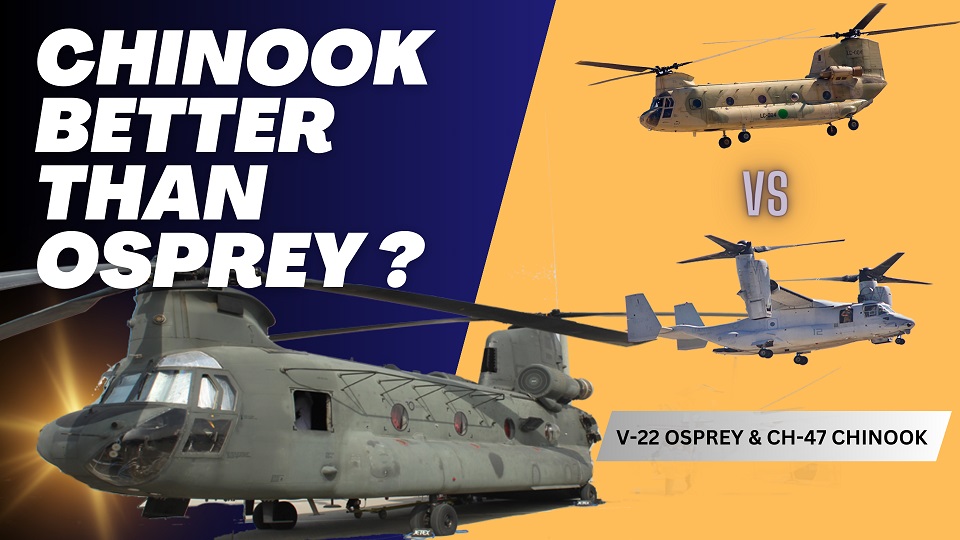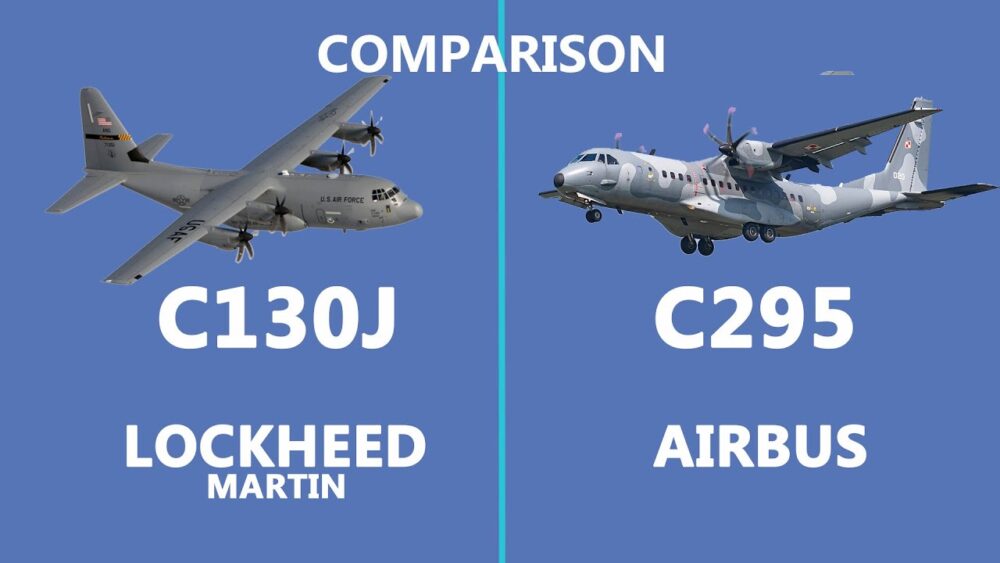Aircraft comparison
Osprey is faster than Chinook helicopter ?

In this article, we’ll delve into two distinct military aircraft that have played essential roles in United Air Force defense. Both aircraft have unique characteristics in terms of usage and flying capabilities. One is capable of vertical takeoff and flies like an aircraft, while the other is a helicopter with two tandem rotors. Let’s explore each of these aircraft in detail..
The speed of helicopters can vary depending on several factors such as their design, engine power, payload, and mission requirements. Generally speaking, the Osprey (specifically referring to the V-22 Osprey) is faster than the Chinook helicopter.
The V-22 Osprey is a tiltrotor aircraft, meaning it can take off and land vertically like a helicopter but also tilt its rotors forward to fly like an airplane. This design allows the Osprey to achieve higher speeds compared to conventional helicopters. The cruising speed of the V-22 Osprey is around 241 knots (277 mph or 446 km/h).
On the other hand, the Chinook helicopter, such as the Boeing CH-47 Chinook, has a cruising speed typically around 170 knots (196 mph or 315 km/h). While the Chinook is a highly capable and versatile helicopter known for its heavy-lift capabilities and reliability, it generally operates at lower speeds compared to the Osprey.
The comparison between an Osprey and a Chinook helicopter involves contrasting two distinct aircraft with different designs, capabilities, and purposes:
MV-22 Osprey details:
The Osprey has garnered significant controversy since its inaugural flight, primarily stemming from issues associated with its tiltrotor design. These challenges have led to several incidents and crashes, resulting in the tragic loss of pilots and crew members and prompting multiple groundings of the aircraft.
However, efforts are underway to address these technical issues swiftly, with plans to rectify the problems and resume flights promptly. Despite these setbacks, the Osprey remains crucial in operational contexts, offering enhanced capabilities for transporting both cargo and crew members, underscoring its pivotal role in various missions.
Except for the United States and Japan, no other country has been granted authorization to utilize the Osprey aircraft. Its unique design and specialized nature, being built in the United States, likely necessitate governmental permission for export to other nations.
The Osprey stands out for its groundbreaking design and innovation, featuring the ability to transition from vertical to horizontal rotor positions while also generating thrust like a conventional aircraft.
- MV-22 Osprey:
- The MV-22 Osprey is a tiltrotor aircraft, meaning it can take off and land like a helicopter but fly like a fixed-wing aircraft once airborne.
- It’s primarily used for vertical takeoff and landing (VTOL), troop transport, cargo transport, and aerial refueling.
- The Osprey has a unique ability to combine the vertical lift capability of a helicopter with the speed and range of a turboprop aircraft.
- It can carry up to 24 troops or 20,000 pounds of internal cargo and has a top speed of around 315 miles per hour (507 km/h).
- The Osprey is utilized by the U.S. Marine Corps, U.S. Air Force Special Operations Command, and other military forces around the world.
Boeing CH-47 Chinook:
The Chinook helicopter stands as a testament to unparalleled engineering and innovation, making it one of the most distinctive aircraft ever constructed. Since its inception, no other nation has attempted to replicate its singular design, owing to the extraordinary precision and aerospace technology required for its construction. This helicopter, revered as an engineering marvel, has become a staple in major battlegrounds, renowned for its exceptional capacity to transport troops and cargo to any destination. Remarkably versatile, it operates seamlessly on both land and water surfaces, boasting an integrated floating system that enhances its capabilities even further.
Selected countries have been granted permission to utilize the Chinook helicopter, showcasing its global appeal and strategic importance. Furthermore, ongoing development efforts are underway to enhance the speed and carrying capacity of the next version of this iconic aircraft. Renowned for its exceptional safety record, the Chinook stands as one of the safest helicopters in operation today, with a remarkably low incidence of crashes. Its versatility is unmatched, making it an invaluable asset for operations in diverse terrains and environments.
- Boeing CH-47 Chinook:
- The Chinook is a tandem rotor helicopter, known for its distinctive twin-rotor design.
- It’s a heavy-lift helicopter primarily used for troop transportation, artillery emplacement, battlefield resupply, and various other missions.
- The Chinook has a rear loading ramp for cargo and troops, making it well-suited for quick loading and unloading.
- It can carry up to 55 troops or 24,000 pounds of cargo internally and has a top speed of around 170 miles per hour (274 km/h).
- The Chinook is widely used by the U.S. Army and various other military forces worldwide, including the UK, Canada, and others.
Comparison:
- Design: The Osprey is a tiltrotor aircraft, while the Chinook is a tandem-rotor helicopter.
- Speed and Range: The Osprey has a higher top speed and longer range compared to the Chinook due to its fixed-wing aircraft capabilities.
- Payload Capacity: The Chinook generally has a higher payload capacity for both troops and cargo compared to the Osprey.
- Versatility: While both aircraft are versatile in their own right, Osprey’s ability to take off and land vertically as well as fly at high speeds over long distances gives it a unique advantage in certain scenarios. However, the Chinook’s ability to carry larger payloads makes it better suited for heavy lift operations.
- Cost and Maintenance: Maintenance and operating costs may vary between the two aircraft, with tiltrotor technology typically being more complex than traditional helicopter designs.

Aircraft comparison
Comparison of the C130J vs C295 cargo aircraft

The Airbus C295 and Lockheed Martin C-130J are two of the most versatile military transport aircraft, each known for its unique strengths across various missions.
While both aircraft are highly capable in transporting troops, cargo, and performing specialized missions, they cater to different operational needs based on their size, capacity, range, and adaptability.
In this comparison, we will delve into the specifications, performance, and operational advantages of the C295 and C-130J, providing insights to help evaluate their suitability for modern military and logistical challenges.
Air India Might Operate Tata-Made New Airbus C295 Aircraft
The Airbus C295 is designed with a focus on short take-off and landing (STOL) capabilities, making it highly effective for regional and remote area transport. This STOL ability allows it to operate from shorter, less-prepared runways, ideal for accessing challenging locations.
In contrast, the Lockheed Martin C-130J prioritizes a larger payload capacity and greater range, enabling it to carry more cargo over longer distances, which is essential for strategic operations. This extended range and load capability make the C-130J well-suited for larger, more demanding missions requiring heavy transport and extended reach.
Here is the Specification of both aircraft.
Length: The Airbus C-295 measures 24.46 meters (80 feet 3 inches) in length, while the Lockheed Martin C-130J is significantly longer at 29.79 meters (97 feet 9 inches).
Max Takeoff Weight: The C-295 has a maximum takeoff weight of 21,000 kg (46,297 lb) for normal operations and 23,200 kg (51,147 lb) for overload. In contrast, the C-130J has a significantly higher maximum takeoff weight of 70,307 kg (155,000 lb).
Fuel Capacity: The C-295 has a fuel capacity of 7,650 liters (2,020 US gallons) and offers an optional in-flight refueling probe. The C-130J, while specific capacity details are not listed, can carry larger amounts of fuel to support its extended range.
Powerplant: The C-295 is powered by two Pratt & Whitney Canada PW127G turboprop engines, providing 1,972 kW (2,644 hp) each, while the C-130J features four Rolls-Royce AE 2100D3 turboprop engines, delivering 3,458 kW (4,637 shp) each.
Range: The C-295 has a normal payload range of 1,555 km (966 miles), whereas the C-130J boasts a maximum range of 3,300 km (2,100 miles) with a normal payload of 15,422 kg (34,000 lb).
Hardpoints: The C-295 features six hardpoints for carrying additional payloads, with a maximum capacity of 800 kg (1,764 lb) on inboard pylons. The C-130J is equipped with six wing hardpoints that allow it to carry extra fuel tanks, sensors, and a variety of weapons, making it more versatile for both cargo and combat roles.
Propellers: The C-295 uses six-bladed Hamilton Sundstrand HS-568F-5 composite propellers, while the C-130J is equipped with six-bladed Dowty R391 composite constant-speed propellers that feature fully feathering and reversible pitch capabilities.
The C295 is equipped with advanced avionics and navigation systems, including a digital cockpit with modern displays and controls, and an integrated mission system for surveillance and communication tasks.
The C-130J Hercules is equipped with advanced avionics and navigation systems as well. It features a modern glass cockpit with digital displays and controls, enhancing situational awareness for the crew. The aircraft includes an integrated mission system that supports various tasks, such as aerial refueling, cargo management, and tactical operations. Additionally, its advanced communication systems ensure reliable connectivity during missions, making it effective for both military and humanitarian operations.
Airbus Final Assembly Line Adapts for A350 Freighter Production
Recently, Airbus inaugurated a Final Assembly Line (FAL) for the C295 aircraft in Vadodara, Gujarat, as part of the ‘Make in India’ initiative. This project aims to deliver 56 C295 aircraft to the Indian Air Force (IAF), with 40 units being manufactured locally and 16 delivered from Spain. So far, six aircraft have already been delivered.
Meanwhile, Lockheed Martin has partnered with Tata Advanced Systems to strengthen support for India’s C-130J Super Hercules fleet. This collaboration aims to set up a Maintenance, Repair, and Overhaul (MRO) hub in India and increase local production of C-130J units, pending approval from the US and Indian governments.
The C-295 has been acquired by several countries, including India, Spain, Egypt, Poland, Canada, Brazil, Mexico, and Portugal, with a total of 225 units built. In comparison, as of March 2022, 500 C-130J aircraft have been delivered to 26 operators across 22 countries.
-

 Aviation2 months ago
Aviation2 months agoMicrosoft Flight Simulator Raises $3 Million to Bring Back the An-225 Mriya
-

 Airlines2 months ago
Airlines2 months agoQatar Citizens Can Travel to the United States Without a Visa
-

 Aviation2 months ago
Aviation2 months agoQatar Airways bans these new Electronic Devices on plane
-

 Defence2 months ago
Defence2 months agoWhich Country Has the Largest Fleet of Fighter Aircraft?
-

 Airlines1 week ago
Airlines1 week agoDAMAC Air: Dubai’s New Luxury Airline Offers Free Flights for Registration
-

 Airport2 months ago
Airport2 months agoWestern Sydney Airport Welcomes Its First Plane After 6 Years of construction
-

 Airlines7 days ago
Airlines7 days agoAir India to Launch aircraft maintenance training institute in Bengaluru
-

 Aviation2 months ago
Aviation2 months agoDid you know ? Once Boeing 747 carried 1088 passenger in 1991








